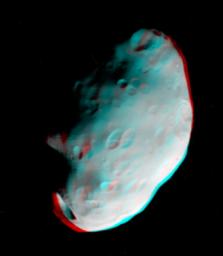
|
Pandora Anaglyph
- Click the image above for a larger view
- Full-Res JPEG (334 x 384) (9.0 kB)
- Full-Res TIFF (334 x 384) (385.4 kB)
Caption:
Craters on Saturn's moon Pandora exhibit clarity and depth in this anaglyph, or 3D view, from Cassini.
This stereo view shows the rugged, irregular shape caused by multiple large impacts, and the smaller craters formed most recently on this tiny satellite. Gravity is weak on Pandora (84 kilometers, or 52 miles across), but it does hold onto the loose material formed by catering. The mantle of fine debris partially hides older craters, slowly covering and filling them as it coats the moon.
See PIA07632 for a color view of Pandora, taken at the same time.
The image was taken in visible light with the Cassini spacecraft narrow-angle camera on Sept. 5, 2005, at a distance of approximately 52,700 kilometers (32,700 miles) from Pandora. Image scale is 312 meters (1,024 feet) per pixel.
Background Info:
The Cassini-Huygens mission is a cooperative project of NASA, the European Space Agency and the Italian Space Agency. The Jet Propulsion Laboratory, a division of the California Institute of Technology in Pasadena, manages the mission for NASA's Science Mission Directorate, Washington, D.C. The Cassini orbiter and its two onboard cameras were designed, developed and assembled at JPL. The imaging operations center is based at the Space Science Institute in Boulder, Colo.
For more information about the Cassini-Huygens mission visit http://saturn.jpl.nasa.gov/home/index.cfm . The Cassini imaging team homepage is at http://ciclops.org .
Cataloging Keywords:
| Name | Value | Additional Values |
|---|---|---|
| Target | Pandora | |
| System | Saturn | |
| Target Type | Satellite | |
| Mission | Cassini-Huygens | |
| Instrument Host | Cassini Orbiter | |
| Host Type | Orbiter | |
| Instrument | Imaging Science Subsystem (ISS) | |
| Detector | Narrow Angle Camera | |
| Extra Keywords | Color, Crater, Impact, Visual | |
| Acquisition Date | ||
| Release Date | 2006-12-29 | |
| Date in Caption | ||
| Image Credit | NASA/JPL/Space Science Institute | |
| Source | photojournal.jpl.nasa.gov/catalog/PIA08339 | |
| Identifier | PIA08339 | |
